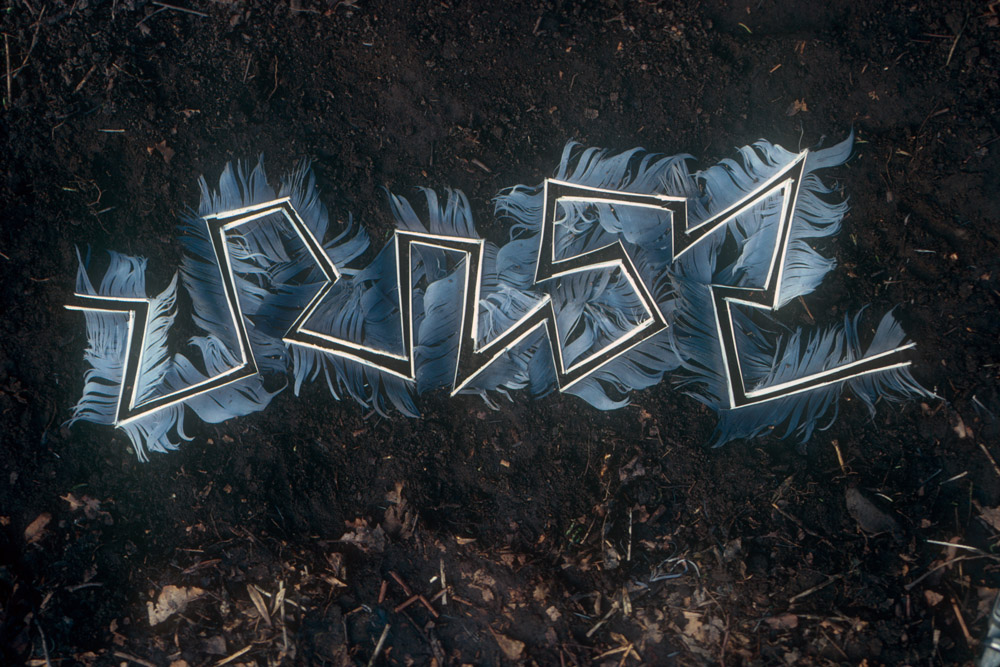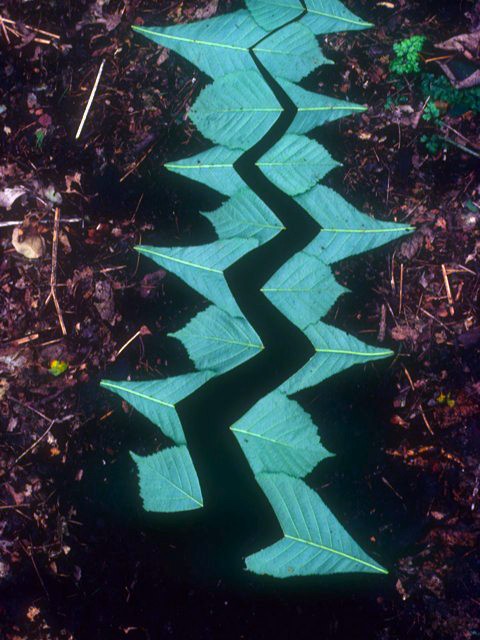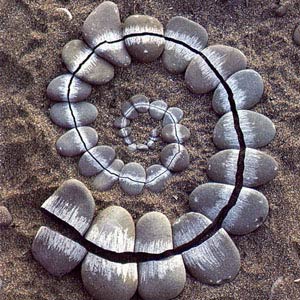Engaging in outdoor art-making since the 1970s, Andy Goldsworthy is the most well-known environmental artist of our time. Decades of practice have nurtured a humble and sensitive attention to form, light, color, condition, and temporality. His works range from delicate and transitory arrangements to massive, sturdy installations. Like many land artists, he uses only natural materials found at the site of construction, foregoing the use of glue, rope, or other manmade tools with the intent to gain an understanding of the natural material’s intrinsic qualities. Through the manipulation of leaves, sticks, stones, dirt, feathers, and even icicles, Goldsworthy dazzles us with stunning beauty and demands an appreciation of nature’s own creations.
Most notable, perhaps is the inherent temporal nature of his installations. Goldsworthy taps into nature’s uncertainty, and this tension is present in his works. Much like Money and the impressionist, Goldsworthy pays close attention to the way sunlight falls on objects or the way wind may animate leaves. “I have become aware of how nature is in a state of change and how that change is the key to understanding. I want my art to be sensitive and alert to changes in material, season and weather… My sculpture can last for days or a few seconds – what is important for me is the experience of making. I leave all my work outside and often return to watch it decay” (Andy Goldsworthy Digital Catalogue: Selected Extracts).
Goldsworthy’s use of photography is an important aspect of his practice. Beginning strictly as a documentary practice, his photography evolved into a means of capturing, archiving, and sharing his temporal pieces. “It is well known that every ephemeral work that Goldsworthy has made is invariably photographed, always immediately following the making, and often in revisiting the work. He has described the process of photography as one that is ‘routine’ and ‘demanding.’ Certainly in terms of the setting up, timing, viewing, and awareness that it requires of Goldsworthy, the photographing process constitutes a performative corollary to the making of the sculpture” (Andy Goldsworthy : Digital Catalogue). Goldsworthy takes all the photographs himself, using three separate cameras, and regular lenses with no filters. He prefers maximum depth of field and brackets his exposures to produce the greatest range of quality and ensure the influences of the constantly fluctuating environment are not overlooked. “If the work is one that is ‘activated’ by a particular type of lighting, or by the flow of water or incoming tide for instance, or is ‘time-based’, then Goldsworthy will take multiple successive shots, usually framed from the same vantage point” (Andy Goldsworthy Digital Catalogue : Photography). Goldsworthy utilizes the photographic evidence of his work as a means of reflection, to reassess the piece and inform future projects.
Since much of Goldsworthy’s sculptures and installations are created in private or remote areas, and begin to fade away the before they are even complete, the photographic renderings of his work are often the only manifestation of his genius that the public is blessed to experience. Through exhibitions or published images, Goldsworthy mediates the accessibility to his work by which pieces are chosen to be printed and the manner in which the piece is photographed and ultimately viewed. I personally consider these photographs as incredible gifts; the probability that I will ever be present in the moment of a Goldsworthy creation is rare, so their photographic likeness fixed in time is a blessing.
The Andy Goldsworthy Digital Catalogue is an extensive archive of his work. This incredible resources is a collaborative effort between Andy Goldsworthy, The Crichton Foundation, and the University of Glasgow’s Crichton Campus and Humanities Advanced Technology and Information Institute (HATII). Documenting over 2700 of Goldsworthy’s scultpures during a ten year period (1976-1986), the result is unprecedented access to his portfolio and sketchbook diaries, as well as several interviews and reflections on specific pieces. Users may search works by date, form, material, and place, and view quality images of the installations, which only existed for a brief moment in time.
To learn more about Andy Goldsworthy and his incredible work, check out Rivers and Tides, a moving documentary that paints a portrait of the artist and his work. The first movie allowed to be made of his process, Director Thomas Riedelsheimer takes us on a journey through four countries, across four seasons, and reveals the unpredictability of Goldsworthy’s elusive process.
Works by Goldsworthy:
Feathers plucked from dead heron, cut with sharp stone, stripped down one side // About three-and-a-half feet overall length // Made over three calm days, cold mornings, frost // smell from heron becoming pungent as each day warmed up // Swindale Beck Wood, Cumbria // 24- 26 February 1982
Partly stripped sycamore twigs // Ilkley, Yorkshire // April 1978
Stacked icicles, about 8 inches in length // Morecambe Bay, Lancashire // February 1978
Sycamore leaves, stitched together with stalks, hung from a tree // Glasgow, Lanarkshire // 1 November 1986










Güzel makaleyi paylaştığınız için teşekkürler. Ondan bilgi toplamalıyız. Daha fazla bilgi için
Para Kule sitesini ziyaret edebiliriz.
perfect this post
ساندویچ پانل سقفی
I appreciate the time and effort you put into researching and writing your articles. Your dedication to your craft is evident in the quality of your work.CalStampede
Thanks for spreading this knowledge to us.
ساندویچ پانل
Get ready to challenge and explore the world of drifting with the game Drift Hunters. Set your status to “ready” and start this adventure with me!
best thanks for your good articles
ساندویچ پانل تنها راه ساخت و ساز با هزینه کم
I want to introduce a site in the field of sandwich panels
قیمت ساندویچ پانل
ساندویچ پانل دیواری
is it really good and when you wann buy stand of monitor go to the stand store persian shop.
زیر مانیتوری
نمایندگی ایسوس
تعمیرات لپ تاپ ایسوس
تعمیرات آل این وان ایسوس
تعمیرات تبلت ایسوس
تعمیرات شبکه ایسوس
تعمیر کامپیوتر ایسوس
تعمیر موبایل ایسوس
نمایندگی سامسونگ
تعمیر موبایل
تعمیرات تبلت
تعمیرات لپ تاپ
تعمیر ساعت هوشمند
تعمیرات مانیتور
دیجی کالا
That’s great. I was impressed by your writing. VanillaGiftCardBalance
We both have the same problem. Go to the game fall guys to play exciting action games while you look for the answer.
The gameplay is simple but very addictive. Drift Boss does a great job of keeping players coming back.
ساندویچ پانل، محصولی پیشرفته و کارآمد در صنعت ساختمان است که از ترکیب دو لایه ورق فلزی بیرونی و یک هسته عایق درونی تشکیل میشود. این محصول با دارا بودن ویژگیهای منحصر به فرد، به سرعت جای خود را در پروژههای ساختمانی متنوع باز کرده است.
کاربرد ساندویچ پانل
If you plan to build a villa at a low cost and affordable, the best option is to use sandwich panels to build a prefabricated villa building. Sandwich panel is a type of building material that is produced in a prefabricated form in a factory and increases the speed of construction and reduces project implementation costs.
کانکس ویلایی
clean room sandwich panel
ساندویچ پانل کلین روم
Covering the walls of all kinds of production, industrial, warehouse, sports, poultry, mushroom breeding hall
All kinds of guardhouses, workshops, restrooms
cold room
clean room
Using wall sandwich panels
ساندویچ پانل دیواری
Art has no boundaries.
مشخصات ساندویچ پانل
Art has no boundaries.
مشخصات ساندویچ پانل
Antalya Excimer Laser Treatment, with laser or a different surgical intervention to be applied by Eye Surgery Antalya, which has the best eye surgeons in Antalya, we save the person from wearing glasses and achieve distance and near vision without glasses.Due to the difficulties of using prescription glasses or lenses, over time, people want to stop using glasses or contact lenses for physical or emotional reasons.This intervention is popularly known as Antalya Eye Draw surgery.
Dental implants in Antalya are a popular choice for international patients seeking affordable yet excellent dental care. Among the various options available, All on 4 implants stand out for their efficiency and durability, offering a comprehensive solution for those needing a full set of replacement teeth. Antalya’s beautiful Mediterranean coastline and rich cultural attractions provide a relaxing backdrop for recovery, making it a favored destination for dental tourism. Patients can enjoy world-class services, including dental crowns and implants, at renowned facilities like DCI Dental Clinic. With a focus on precision and patient care, Antalya’s dental clinics offer trusted solutions to restore your smile with durable and natural-looking results.
Antalya Hymenoplasty (hymenoplasty) is a surgical procedure performed to restore the hymen. It is generally preferred for aesthetic reasons and can be applied with various techniques.
Permanent Hymenoplasty: It provides permanent results and more complex surgical techniques are used.
Temporary Hymenoplasty: It gives temporary results and is often preferred for weddings or special occasions.
The surgery can be performed under local or general anesthesia. The evaluation should be performed by obstetricians and gynecologists, taking into account medical history and wishes. The rehabilitation period is usually short.
Rhinoplasty Antalya – Dr. Erkal opened his private practice in Antalya in 2017. He has been practicing otorhinolaryngology in this clinic ever since.
Our clinic has focused exclusively on rhinology from the very beginning. Believing that success can be achieved with maximum specification in a subject area, Dr. Erkal follows the scientific updates in this field and only performs esthetic and functional rhinoplasty surgeries. In our clinic, medical esthetic procedures such as botox, fillers, skin care, epilation are not performed.
Kondromin is a nutritional supplement brand specifically formulated to support joint and bone health. The physical challenges of daily life, the aging process, and an active lifestyle can cause wear and tear on joints and bones over time. Kondromin products provide the nutrients needed to slow down this process, relieve joint pain, and increase mobility.
Doğanın enerjisini ve tazeliğini bir araya getiren Organik Arpa Çimi Tozu, Çimciden güvencesiyle sofralarınıza geliyor. Genç arpa bitkisinin besin dolu yapraklarından elde edilen bu toz, zengin vitamin, mineral ve klorofil içeriği ile günlük beslenmenizi destekler. Organik olarak yetiştirilmiş arpa çimi ile sağlıklı yaşamınıza doğal bir dokunuş katın.
Let’s share out thoughts and hang out sometimes. Reach me at my site. igoal88
Your article has enriched my understanding of [topic] in ways I never thought possible. sòng bạc ae sexygaming
Dental implants in Antalya are a popular choice for international patients seeking affordable yet excellent dental care. The city’s beautiful Mediterranean coastline and rich cultural attractions offer a relaxing backdrop for recovery, making it a popular spot for dental tourism. Patients can enjoy world-class dental services while experiencing the best of Antalya’s scenic beauty and hospitality. With a focus on precision and patient care, Antalya’s dental clinics provide a trusted solution for those looking to restore their smile with durable and natural-looking dental implants.
good thanks but my questions about this title not answer yet
خرید اینترنتی لباس مردانه
The depth of research and clarity of presentation in your writing are remarkable หวย ฮานอย vip
افرادی که به دنبال کاهش استرس و اضطراب هستند، میتوانند از مصرف شربت ایمیونس بهرهمند شوند. این شربت میتواند به آرامش ذهن و کاهش علائم استرس کمک کند، که این امر میتواند به بهبود کیفیت زندگی افراد کمک کند.شربت ایمیونس میتواند بهعنوان یک مکمل طبیعی در کنار رژیم غذایی سالم و متعادل قرار گیرد. با توجه به ترکیبات مفید و خاص این شربت، مصرف منظم آن میتواند به بهبود سلامت عمومی و کیفیت زندگی کمک کند.شربت ایمیونس بهویژه در فصلهای سرد سال و در زمانهایی که احتمال ابتلا به بیماریهای تنفسی بیشتر است، میتواند به تقویت سیستم ایمنی و کاهش خطر ابتلا به این بیماریها کمک کند.https://daroophen.com/product/vitabiotics-immunace-liquid
thanks for buy cold and hots parts visit this page web خرید سیستم سرمایش و گرمایش خانه
STBEmu codes is an emulator that mimics the functionality of a physical IPTV set-top box. It provides a user-friendly interface that is familiar to users of traditional cable or satellite TV. The app is compatible with Android devices, including smartphones, tablets, and Android TV boxes, making it a versatile option for accessing IPTV content.
Xtream Codes has gained significant popularity in the IPTV community as a powerful solution for managing and delivering IPTV content. It allows users to access a wide range of live TV channels, movies, and on-demand content through various applications, including Xtream Player. In this article, we’ll explore what Xtream Codes are, how they work, and how to use Xtream Player effectively.
In Slope Game, every second is a challenge!
Andy Goldsworthys art merges nature with human creativity, inspiring designs that balance natural beauty with functionality. Similarly, the preston and york leather coat combines timeless elegance with practicality, perfect for those who value artistic expression and quality craftsmanship in their wardrobe. It’s a true reflection of style inspired by nature’s charm.
Antalya Web Tasarım, modern ve kullanıcı dostu web siteleri ile markanızı dijital dünyada bir adım öne taşıyor. SEO uyumlu, mobil cihazlara tam uyumlu tasarımlar ve yenilikçi çözümlerle işletmenizin hedef kitlesine etkili bir şekilde ulaşmasını sağlıyoruz. Dijital stratejilerimizle, işletmenizin başarısını güçlendirmek için buradayız!
As for now, I’m enthralled with the artwork of Andy Goldsworthy; the artwork here is the simplicity of nature in its natural way. Likewise, nature and art may be surprising, as when you wake up in the morning and your car battery is no longer charged. However, in the event of a battery die, car battery replacement dubai services providers from Wefix Car Await to make sure you are not left stranded.
good articles thanks for this
پشتیبانی وب سایت
best at all thanks for this article of site we sells cooling and hot
راهنمای خرید تجهیزات گرمایشی و سرمایشی
Dentoper Fethiye, Fethiye’de diş sağlığı alanında öncü bir merkez olarak hizmet vermektedir. Uzman diş hekimlerimiz ve modern teknolojilerle donatılmış kliniğimiz, hastalarımıza güvenilir ve etkili tedaviler sunmayı amaçlamaktadır. Özellikle “Fethiye implant” tedavilerinde elde ettiğimiz başarılı sonuçlar, kliniğimizin tercih edilmesinde önemli bir faktör olmaktadır. Hastalarımız, implant tedavilerinde güvenle Dentoper Fethiye’yi seçmekte ve uzun ömürlü, estetik sonuçlar elde etmektedir.
Dentoper Fethiye Diş Kliniği olarak sadece implant tedavileri değil, estetik diş hekimliği, diş kaplama, diş beyazlatma gibi geniş bir yelpazede hizmet sunmaktayız. Hastalarımızın ihtiyaçlarına özel tedavi planları oluşturuyor ve her adımda kişisel bakım sunuyoruz. İleri teknoloji cihazlar ve steril ortamlarda yapılan tedavilerimiz, hasta memnuniyetini en üst düzeye çıkarmayı hedeflemektedir.
Fethiye’de diş sağlığı hizmetleri arayan hem yerli hem yabancı hastalarımıza en iyi tedavi çözümlerini sunmaktan gurur duyuyoruz. Dentoper Fethiye, diş sağlığınızı korumak ve estetik bir gülüşe sahip olmanızı sağlamak için buradadır. Kliniğimizdeki tüm hizmetler, hijyenik ve konforlu bir ortamda, güvenilir ve deneyimli bir ekip tarafından sunulmaktadır. Sizin de sağlıklı bir gülüşe kavuşmanızı sağlamak için Dentoper Fethiye’yi tercih edin.
buy feng shui itemsVisit our store today to explore our full variety
of feng shui products and make all your wishes occur!
You have helped me and many others with this article.
เว็บ 123vip
هوشمندسازی همچنین به نگهداری پیشگیرانه کمک میکند. سیستمهای هوشمند میتوانند مشکلات فنی را پیش از بروز خرابیهای بزرگ شناسایی کنند و کاربران را از نیاز به تعمیر یا تعویض قطعات آگاه سازند. این قابلیت باعث کاهش هزینههای تعمیرات و افزایش عمر مفید سیستمها میشود.
یکی دیگر از مزایای سیستمهای هوشمند،راهنمای خرید تجهیزات گرمایشی و سرمایشی امکان نظارت و کنترل از راه دور است. کاربران میتوانند از هر نقطهای که به اینترنت دسترسی دارند، دمای محیط را بررسی و تنظیم کنند. این قابلیت بهویژه برای خانههای دوم یا ساختمانهای تجاری مفید است، جایی که ممکن است نیاز به کنترل سیستمها از فاصله دور باشد.
در نهایت، هوشمندسازی سیستمهای گرمایشی و سرمایشی نه تنها باعث افزایش کارایی و صرفهجویی در انرژی میشود، بلکه تجربهای مدرنتر و راحتتر برای کاربران فراهم میکند. با توجه به رشد سریع این فناوری و کاهش هزینههای آن، انتظار میرود در آیندهای نزدیک، این سیستمها به بخشی استاندارد از طراحی ساختمانها تبدیل شوند.
سرویس لوازم خانگی هوم افراز: انتخابی هوشمندانه برای آرامش خانه شما
لوازم خانگی نقش مهمی در آسایش و راحتی زندگی روزمره ایفا میکنند. شرکت هوم افراز با ارائه خدمات تخصصی و دوستانه، تمام نیازهای شما در زمینه سرویس و تعمیرات لوازم خانگی را برآورده میکند. خدمات متنوع و پشتیبانی حرفهای این شرکت، تضمینی برای عملکرد بهتر و عمر طولانیتر دستگاههای شماست.
تعمیر تخصصی یخچال و فریزر با هوم افراز
یخچال و فریزر، از مهمترین دستگاههای هر خانه هستند. در صورت بروز مشکلاتی مانند نشت گاز، خرابی موتور، یا تنظیم نبودن دما، تکنسینهای متخصص هوم افراز با استفاده از قطعات اورجینال و دانش فنی بهروز، دستگاه شما را به حالت ایدهآل بازمیگردانند.
رفع مشکلات سرمایشی: اگر یخچال خنک نمیکند یا برفک زیادی تولید میشود، تیم هوم افراز علت مشکل را شناسایی و رفع میکند.
I appreciate the time and effort you invested in crafting such a thought-provoking piece.
bacarat
Hey! Do you know if they make any plugins to help with SEO?
I’m trying to get my blog to rank for some targeted keywords but I’m not seeing very good results.
If you know of any please share. Cheers!
Have a look at my web-site: طبیب
What’s Taking place i am new to this, I stumbled
upon this I have discovered It positively helpful and it has helped me out loads.
I’m hoping to contribute & assist different customers like its aided me.
Good job.
Also visit my page تخت بیمارستانی برقی صندلی شو
Your article has left a lasting impression on me, and I am grateful for the opportunity to learn from your work.
หวย มาเล ย์ วัน นี้ 4d
Great website you have here. You have such a beautiful way of writing. Excellent article and a really helpful one, thanks for sharing.
Karya Bintang Abadi